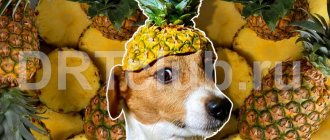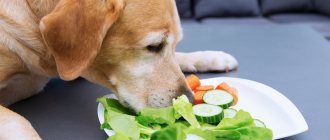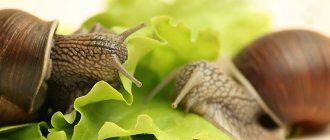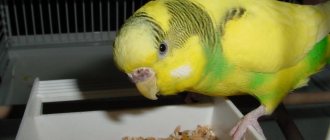Natural food for a dog is far from just meat. The owner needs to understand what vegetables are given to dogs in order to make the diet complete. Dogs, like wild canines, are not obligate predators. They come as close as possible to omnivores, having learned to benefit not only from animal, but also from plant food.
At the same time, it is a mistake to believe that all the same vegetables are safe and healthy for dogs as for people. Some fruits can seriously harm your pet, and some are fed with caution and not too often. Author of the article: Olga Shiltsova, practicing veterinarian, author of the books “Dachshund of Fate” and “Tails of Fortune”
The role of vegetables in a dog's diet
People consider fruits and vegetables to be a valuable source of vitamins. There is some truth to this: dogs, unlike cats, can get vitamin A from beta-carotene. But for dogs, vegetables are important primarily as a source of fiber, non-digestible carbohydrates.
Beneficial functions of fiber:
- Normalizes stool (prevention of not only constipation, but also diarrhea);
- Accelerates the movement of feces through the large intestine;
- Provides a feeling of fullness (the pet gets full faster, while the caloric content of the diet is reduced);
- Regulates changes in blood glucose levels, which is especially important for diabetics.
It is very important to teach your dog to eat vegetables, and not add fiber (bran) in its pure form. Coarse fiber is contraindicated for certain diseases (gastritis, enteritis, stomach ulcers), while boiled or steamed vegetables, on the contrary, are beneficial.
Vegetables are indispensable in the diet of dogs with kidney failure. Zucchini, squash and carrots are relatively low in phosphorus, while potatoes or sweet potatoes can add energy to the diet without increasing protein levels.
For older dogs with heart failure, vegetables are an excellent source of potassium.
Finally, many dogs simply love vegetables. This safe and low-calorie treat can be given separately from the main feeding. A raw carrot as a toy for a puppy whose teeth are itching, a piece of cucumber as a reward for a completed command.
Rules for preparing vegetable dishes for animals
It is important to properly prepare vegetables for your dog so that they benefit the body. Vegetable supplements to the diet are made raw, steamed, baked and stewed. Choose a preparation option, taking into account the properties of the product.
You can alternate processing methods. For elderly pets, food crushed in a blender or grated is suitable. When stewed, vegetables are easier to digest.
Recommendations from veterinarian nutritionists:
- Dogs may swallow celery stalks whole because they are too tough to chew. This will cause intestinal blockage. It must be crushed before serving.
- Do not give vegetables to small breed dogs or puppies raw. They cannot chew them thoroughly, and their weak stomach cannot digest them.
- It is advisable to steam fruits rich in beta-carotene. Thus, this valuable element is better absorbed.
- It is useful to use flaxseed oil to prepare vegetable salad.
- Canned vegetables must not be fed to animals.
- Raw fruits in combination with dairy products will lead to unpleasant consequences.
- It is recommended to dilute meat dishes with root vegetables.
- Heat treatment should be carried out for about 20 minutes. No salt is added.
- Eggplants should not be given more than once every seven days.
- Red vegetables can not only ruin your pet’s snow-white coat, but also cause an allergic reaction.
Video: healthy vegetable casserole recipe for dogs
How many vegetables to give your dog and in what form
Any “allowed” vegetables can be given either raw or boiled. If the dog is not accustomed to vegetables and does not like to chew large pieces, then at first the vegetable part of the diet is ground in a blender (puree) or tinder on a grater.
Ideally, the amount of vegetables in the diet is calculated based on the fiber needs of a particular animal. On average, vegetables are given to dogs based on the amount of 10-20% of the diet.
Vegetable complementary feeding should start with zucchini or pumpkin. Vegetables are introduced one type at a time to observe the dog’s reaction. In case of individual intolerance (vomiting, diarrhea, gas formation in the intestines), the product is permanently excluded from the diet.
Pumpkin is suitable for first feeding
If your pet does not eat vegetables with any sauce, then fiber is introduced into the diet in the form of food additives. This can be soaked bran, seaweed, or pharmaceutical additives such as Eubicor.
Features of the digestive system
To understand what components of the diet and in what quantities are needed by representatives of the canine family, you should study the features of the digestion process.
Interesting Facts:
- Compared to humans, the microflora of dogs is less saturated - 10,000 bacteria per 1 g of tract, while in humans this figure is 10,000,000 per 1 g.
- The number of teeth is 42. The main function is tearing and grinding food, not chewing.
- The number of taste buds is 1,700. For comparison, a person has 9,000.
- Relative to the body, the dog's stomach is 10 times larger than that of herbivores. When full, it contains 10 times more hydrochloric acid than in the human stomach.
- Small colon. At the same time, it takes up to 1 day to process meat, while for herbivores the digestive process takes up to 5 days.
- Dogs' bodies do not have the enzymes necessary to break down plant fiber.
Dogs' bodies are not equipped to produce enzymes to digest plant fiber.
Based on the above, the following conclusions can be drawn. Vegetables and greens are partially absorbed by the body. The state of the intestinal microflora also indicates limited digestive capabilities. The size of the stomach indicates the ability to absorb large volumes of food. The structure of the jaw, the length of the colon and the characteristics of the production of hydrochloric acid indicate the need to eat easily digestible roughage. The taste of food, based on a small number of receptors, does not play an important role in the absorption of food.
Despite the above facts and the absence of a multi-chambered stomach, dogs need vegetables in small quantities
Wild past
Biologically, a dog is a predator. By analogy with her ancestors, she prefers meat.
However, in addition to food of animal origin, the wolf does not disdain plant foods. It feeds on herbs, berries, plant roots, herbivore excrement and insects. At the genetic level, this indicates a need for plant foods.
The basis of the wolf diet is meat
Enzyme fence
When eating herbivores, wolves first of all paid attention to the stomach. There is a version that this behavior is due to the need to receive the digested plant food found in it. Due to the lack of the necessary enzymes in the canine body for its processing, this hypothesis seems logical.
However, this did not solve the problem of lack of enzymes, since the rumen does not contain them. In addition, the wolves’ body is not able to use the remnants of foreign enzymes. These facts refute the thesis of enzyme sampling.
It is more logical to assume that wolves eat semi-digested plant food in order to improve the processing of meat in the body. Therefore, veterinarian nutritionists recommend that when feeding tripe to dogs, do not wash away the green silage from it.
A dog's digestion is not designed to process grass shoots.
Vegetables to give dogs with caution
There are a number of vegetables that some dogs will eat without any problems. But I wouldn’t recommend giving them to your pet without caution.
Beet
I remember panicking as a child when I saw a dog peeing bright pink urine. That's when I learned that eating beets can cause bituria, coloration of urine. My dachshund was simply given boiled beets to eat. Needless to say, the color of feces from this vegetable also changes in an eerie direction.
So why do I avoid feeding beets to dogs. This is a wonderful vegetable, people perceive it as a mild folk remedy for constipation. But beets also have disadvantages:
- May cause allergies;
- Contains levels of nitrates and nitrites that are safe for humans, but significant for dogs;
- Causes bloating, colic and diarrhea in some dogs;
- Beetroot has a high glycemic index and causes spikes in blood sugar levels;
- Contraindicated during pregnancy.
There are too many other, safer sources of plant fiber, so you can safely avoid beets in your dog's diet.
Tomatoes
Tomatoes are often promoted as a natural toothbrush. A paste of these fruits applied to a dog’s teeth helps soften plaque. If your dog loves fresh tomatoes, then a small amount will not do any harm. However, I do not recommend feeding them to your pet on purpose for a number of reasons:
- Risk of allergic reaction;
- Irritates the stomach, should not be given to pets with chronic gastritis;
- Tomatoes cause flatulence and diarrhea in some dogs;
- Tomatoes belong to the “toxic” nightshade family. They contain alkaloids such as alpha-tomatine (a type of solanine) and atropine, which affect cardiac function.
Do not let your dog eat green tomatoes; unripe fruits have a much higher concentration of toxins. Older dogs or animals with cardiac problems should not be given tomatoes in any form.
Focus on yourself: a ripe tomato from your own greenhouse will not harm your pet. And store-bought fruit, stuffed with chemicals and tasteless, is at least useless. Tomatoes can be a seasonal addition to the diet, but nothing more.
bell pepper
Sweet peppers contain the hot alkaloid capsaicin. There is not too much of it in bell pepper, but it can still irritate the stomach lining, especially in dogs with sensitive digestion.
The seeds must be removed from the pepper, and the vegetable itself is best served baked. And again, if there is a choice between zucchini and peppers, it is better to give harmless zucchini.
Broccoli
Did you know that dark green vegetables (for example, broccoli) contain more carotene than orange ones - pumpkin, carrots? Broccoli is a champion not only in terms of provitamin A content, it contains many B vitamins and potassium. And despite all its beneficial properties, the vegetable is on the “stop list” of many dog lovers.
Broccoli contains isocyanates. These substances can cause poisoning in dogs. But for any symptoms to appear, the pet must eat broccoli in incredibly large quantities. The second point: isocyanates interfere with the absorption of iodine from food. Therefore, broccoli is not given to dogs with hypothyroidism.
Broccoli is good for people, but not a “superfood” for dogs
If the dog digests broccoli normally, you can give this vegetable raw or boiled, not exceeding the norm of 5-10% of the diet.
Cucumber
The cucumber itself is not at all dangerous. Raw cucumbers can be given to your dog, along with the peel, as a treat. The disadvantage of cucumbers is that they are watery: the vegetable contains too little fiber. If your dog eats a lot of cucumbers, it will cause diarrhea.
Cucumber cannot serve as a source of fiber in the diet, so it is rather useless. You should not offer your dog pickled or pickled cucumbers; Read about salt poisoning HERE
Potato
Potatoes and sweet yams are common ingredients in commercial dog foods. Potatoes are especially often used for an elimination diet for allergies. Before giving this product to your pet, you need to decide for what purpose you are doing this. Potatoes are a starchy and highly nutritious root vegetable.
Including it in the diet may be beneficial for dogs with kidney failure to increase the calorie intake while reducing the amount of protein. But dogs should no longer be given potatoes after sterilization, so as not to increase the risk of developing obesity.
Potatoes are often fed boiled. If your dog likes raw potatoes, remove the skin in a thick layer to prevent solanine poisoning.
Potatoes are not a harmful product, but they cannot be the only source of fiber. Raw tubers contain about 17% carbohydrates, and 15% of them are starch. Dogs can digest it, but you definitely shouldn’t overuse potatoes.
Choosing eggplant
Scientific research has shown that not all eggplants are created equal. eggplant that is small and firm to the touch is suitable for consumption . If we are talking about eating blue eggplants, then it is better to choose the smallest ones among them. Young eggplants do not contain solanine. Unlike blue, white eggplants are a unique product and completely harmless.
Eggplants with dark flesh or a bitter aftertaste should absolutely not be given to your dog. Due to the high content of poisonous solanine in such eggplant, it will do more harm than good.
Strictly do not give dogs onions and garlic
I try to explain to all owners that onions and garlic are dangerous for dogs. These tangy-tasting fruits contain disulfide, a sulfur compound that causes red blood cell destruction in dogs. If your pet systematically eats garlic or onions, it can cause severe anemia.
If a dog eats a lot of onions, in addition to anemia, he will receive acute poisoning. Allicin, contained in onions and garlic, reduces blood pressure and causes muscle weakness.
Poisoning and anemia may not appear immediately after eating onions, but over time, since disulfides, allicin and allisatin can accumulate in the body.
Finally, onions and garlic contain a lot of essential oils; they are caustic foods that cause irritation to the lining of the stomach and intestines.
In the literature of the 20th century, there are instructions to give dogs a clove of garlic from time to time to prevent helminthic infestation. As a veterinarian, I try to debunk the myth that garlic can rid your pet of parasites (a note about this HERE).
Most often, onion poisoning is associated with eating human food. The dog may reach the barbecue bucket, attracted by the smell of meat, and eat the pickled onions. Owners sometimes give their pets baby food (which often contains onions), leftover soup or a cutlet. Please protect your dogs from such “goodies”.
Blue-utility indicator
Eggplant is beneficial for almost all dogs . To be convinced of this, just look at its rich composition of microelements and vitamins. Eggplant contains vitamins:
- B Plays an important role in the dog's cardiac, muscular and nervous systems.
- B The source of health and normal functioning of the thyroid gland. Necessary for the growth and harmonious development of the body.
- C. Participates in most metabolic processes in dogs.
- B Very important for the dog's fat and carbohydrate metabolism.
- PP. Participates in metabolism.
In addition, eggplant is a storehouse of fiber, which perfectly removes toxins and excess water. Eggplants contain calcium, potassium, iron, magnesium, sodium, phosphorus, which reduces the risk of anemia and cholesterol levels.
Caution: urolithiasis
Owners of dogs with oxalate and urate type urolithiasis should be more careful than others when it comes to choosing vegetables. Dogs with urolithiasis should not be given vegetables high in oxalates and oxalic acid, since these substances are excreted in the urine and can form stones.
Stop list for oxalate urolithiasis: beets, carrots, green beans and other legumes, zucchini, broccoli
Possible: pumpkin
How to cook broccoli
You can feed your pet raw, boiled or stewed broccoli; the choice of cooking method depends solely on your preferences. For older dogs, boiled food , because during the cooking process the food softens and becomes easier to chew. But when cooking, you should refrain from any seasonings, salt and oil, as they have a bad effect on the digestion and well-being of the animal.
Giving this vegetable to your pet will provide its body with protection from harmful bacteria, cell regeneration, strengthening the immune system and maintaining overall nutrient balance. But it is important to remember that broccoli is harmless and even beneficial for dogs only in moderation; excessive consumption of cabbage or other vegetables will negatively affect your dog's health.











